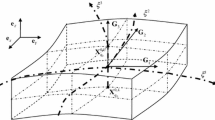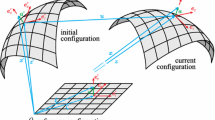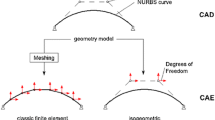Abstract
This paper presents an investigation of interactive-adaptive techniques for nonlinear finite element structural analysis. In particular, effective methods leading to reliable automated, finite element solutions of nonlinear shell problems are of primary interest here. This includes automated adaptive nonlinear solution procedures based on error estimation and adaptive step length control, reliable finite elements that account for finite deformations and finite rotations, three-dimensional finite element modeling, and an easy-to-use, easy-to-learn graphical user interface with three-dimensional graphics. A computational environment, which interactively couples a comprehensive geometric modeler, an automatic three-dimensional mesh generator and an advanced nonlinear finite element analysis program with real-time computer graphics and animation tools, is presented. Three examples illustrate the merit and potential of the approaches adopted here and confirm the feasibility of developing fully automated computer aided engineering environments.
Similar content being viewed by others
References
Fredriksson, B.; Mackerle, J. (1984) Structural Mechanics: Finite Element Computer Programs, 4th edn, Linkøping, Sweden, Advanced Engineering Corp.
Noor, A. K.; Babuška, I. (1987) Quality assessment and control of finite element solutions, Finite Elements in Analysis and Design, 3, 1–26.
PDA Engineering, Costa Mesa, California (1988) PATRAN Plus User Manual.
Structural Dynamics Research Corporation, Milford, Ohio (1992) I-DEAS (Integrated Design Engineering Analysis Software) User Manuals.
Det Norske Veritas Sesam A.S., Høvik, Norway (1993) SESAM User's Manual, SESAM System.
Haugen, B.; Mathisen, K.M. (1989) Large-scale vectorized three-dimensional geometric nonlinear shell analysis on a CRAY X-MP/28 utilizing sparse matrix methods. In Proceeding of the First International Conference on Applications of Supercomputers in Engineering (ASE89), volume FFSAA, pp. 189–205, Southampton, England
Farhat, C.; Crivelli, L. (1989) A general approach to nonlinear FE computations on shared-memory multiprocessors, Comp. Meths. Appl. Mech. Engrg. 72, 153–171.
Damhaug, A.C. (1992) Sparse solution of finite element equations, Dr. Ing. Dissertation, Department of Structural Engineering, The Norwegian Institute of Technology, Trondheim, Norway.
Damhaug, A.C.; Mathisen, K.M.; Okstad, K.M. (1994) The use of sparse matrix methods in finite element codes for structural mechanics applications, Comp. Syst. Engrg., 4, 355–362
Bathe, K.-J., Dvorkin, E.N. (1983) On the automatic solution of nonlinear finite element equations, Comp. Struct., 17, 871–879.
Lee, S.H.; Hsieh, S.S. (1991) Applications of a self-adaptive algorithm to non-linear finite element analysis, Int. J. Numer. Meths. Engrg, 32, 1057–1077.
Shephard, M.S. (1985) Finite element modeling with an integrated geometric modeling environment: Part II Attribute specification, domain differences and indirect element types, Engrg. Comp., 1, 73–85.
Weiler, K.J. (1986) Topological structures for geometric modelling, PhD Thesis, Center for Interactive Computer Graphics, Rensselaer Polytechnic Institute, Troy, New York.
Delmas, J.E.; Tembulkar, J.M. (1990) Geometry based automated finite element modeling and analysis. In FEM in the Design Process, Proceedings of the 6th World Congress on Finite Element Methods, Banff, Alberta, Canada, Robinson J. (editor), pp. 280–286, Great Bidlake Manor, UK, Robinson and Associates.
Shephard, M.S. (1988) Approaches to the automatic generation and control of finite elements meshes, Appl. Mech. Rev., 41, 169–185.
Peraire, J.; Vahdati, M.; Morgan, K.; Zienkiewicz, O.C. (1987) Adaptive meshing for compressive flow computations, J. Comp. Phys., 72, 449–466.
Shephard, M.S.; Georges, M.K. (1991) Automatic three-dimensional mesh generation by the finite octree technique, Int. J. Numer. Meths. Engrg., 32, 709–749.
Leal, D. (1991) Progress towards a standard for finite element data. In Proceedings of the 3rd International Conference on Quality Assurance and Standards in Finite Element Analysis, Stratford-upon-Avon, UK, September, NAFEMS.
Hunten, K.A. (Editor) (1991) FEA Reference Model, ISO TC184/SC4/WG3 Document N21.
Riks, E. (1972) The application of Newton's method to the problem of elastic stability, J. Appl. Mech., 39, 1060–1066.
Wempner, G.A. (1971) Discrete approximations related to nonlinear theories in solids, Int. J. Solids Struct., 7, 1581–1599.
Crisfield, M.A. (1981) A fast incremental/iterative solution procedure that handles snap-through, Comp. Struct., 13, 55–62.
Schweizerhof, K.H.; Wriggers, P. (1986) Consistent linearization for path following methods in nonlinear FE analysis, Comp. Meths. Appl. Meth. Engrg., 59, 261–279.
Fried, I. (1984) Orthogonal trajectory accession to the nonlinear equilibrium curve, Comp. Meths. Appl. Mech. Engrg., 47, 283–297.
Zienkiewicz, O.C.; Zhu, J.Z. (1987) A simple error estimator and adaptive procedures for practical engineering analysis. Int. J. Numer. Meths. Engrg., 24, 337–357.
Hinton, E.; Campbell, J.S. (1974) Local and global smoothing of discontinuous finite element functions using a least squares method, Int. J. Numer. Meths. Engrg., 8, 461–480.
Zienkiewicz, O.C.; Zhu, J.Z. (1992) The superconvergent patch recovery anda posteriori error estimates. Part 1: The recovery technique, Int. J. Numer. Meths. Engrg., 33, 1331–1364.
Blacker, T.; Belytschko, T. (1994) Superconvergent patch recovery with equilibrium and conjoint interpolant enhancements, Int. J. Numer. Meths. Engrg., 37, 517–536.
Zhu, J.Z.; Zienkiewicz, O.C. (1988) Adaptive techniques in the finite element method, Commun. Appl. Numer. Meths., 4, 197–204.
Okstad, K.M. (1994) Adaptive methods for nonlinear finite element analysis of shell structures, Dr. Ing. Dissertation, Department of Structural Engineering The Norwegian Institute of Technology, Trondheim, Norway
Okstad, K.M.; Mathisen, K.M. (1994) Towards automatic adaptive geometrically nonlinear shell analysis. Part I: Implementation of anh-adaptive mesh refinement procedure, Int. J. Numer. Methods. Engrg., 37, 2657–2678.
Fyrileiv, O. (1991) FENRIS—Finite Element NonlineaR Integrated System, user's manual, Veritas Sesam Systems A.S., Høvik, Norway.
Aamnes, K. (1993) GL view Command Summary, SINTEF Industrial Mathematics, Trondheim, Norway.
Mangerud, A.: Mathisen, K.M.; Okstad, K.M.; Syljuåsen, Ø.A. (1993) FENRIX—Finite Element NonlineaR Integrated X-environment, Users Manual, Technical Report R-8-93, Department of Structural Engineering, The Norwegian Institute of Technology, Trondheim, Norway.
Arnholm, C. (1989) SIF Results Interface File, File Description, Veritas Sesam Systems A.S., Høvik, Norway.
Bergan, P.G.; Nygård (1985) Nonlinear shell analysis using free formulation finite elements. In Proceedings of the Europe-US Symposium on Finite Element Methods for Nonlinear Problems, Trondheim, Norway, Bergan, P.G.; Bathe, K.-J.; Wunderlich, W. (Editors) New York and Tokyo, Springer-Verlag.
Nygård, M.K. (1986) The free formulation for nonlinear finite elements with applications to shells, Dr. Ing. Dissertation, Division of Structural Mechanics, The Norwegian Institute of Technology, Trondheim, Norway.
Simo, J.C.; Fox, D.D. (1989) On a stress resultant geometrically exact shell model. Part I: Formulation and optimal parametrization, Comp. Methds. Appl. Mech. Engrg., 72, 267–304.
Simo, J.C.; Fox, D.D.; Rifai, M.S. (1989) On a stress resultant geometrically exact shell model. Part II: The linear theory: computational aspects, Comp. Meths. Appl. Mech. Engrg, 73, 53–92.
Simo, J.C.; Fox, D.D.; Rifai, M.S. (1990) On a stress resultant geometrically exact shell model. Part III: Computational aspects of the nonlinear theory, Comp. Meths. Appl. Mech. Engrg., 79, 21–70.
Perić, D.J.; Owen D.R.J. (1991) The Morely thin shell finite element for large deformations problems: Simplicity versus sophistication. In Proceedings of the 4th International Conference on Nonlinear Engineering Computations (NEC-91), Split, Yugoslavia, Biaćanić, N.; Marović, P.; Owen, D.R.J.; Mihanović, A. (Editors).
McCleary, S.L.; Knight, N.F. Jr. (1990) Error detection and control for nonlinear shell analysis. In FEM in the Design Process, Proceedings of the 6th World Congress on Finite Element Methods, Banff, Alberta, Canada, Robinson, J. (Editor) pp. 192–201, Great Bidlake Manor, UK, Robinson and Associates.
Hartung, R.F.; Ball, R.E. (1973) A comparison of several computer solutions to three structural shell analysis problems, Technical Report AFFDL-TR-73-15, U.S. Air Force.
Almroth, B.O.; Brogan, F.A. (1981) Computational efficiency of shell elements. In Nonlinear Finite Element Analysis of Plates and Shells, Hughes, T.J.R.; Pifko, A.; Jay, A. (Editors), volume 48, pp. 147–165, ASME.
Knight, N.F., Jr.; McCleary, S.L.; Macy, S.C.; Aminpour, M.A. (1989) Large-scale structural analysis: The structural analyst, the CSM testbed and the NAS system, Technical Memorandum, 100643, NASA Langley Research Center, Hampton, Virginia.
Almroth, B.O.; Brogan, F.A.; Stanley, G.M. (1979) Structural Analysis of General Shells, Vol. II: User Instructions for the STAGS(C-1) Computer Code, Lockheed Report LMSC-D33873.
Author information
Authors and Affiliations
Rights and permissions
About this article
Cite this article
Mathisen, K.M., Okstad, K.M. Interactive-adaptive geometrically nonlinear analysis of shell structures. Engineering with Computers 12, 63–83 (1996). https://doi.org/10.1007/BF01299393
Issue Date:
DOI: https://doi.org/10.1007/BF01299393




